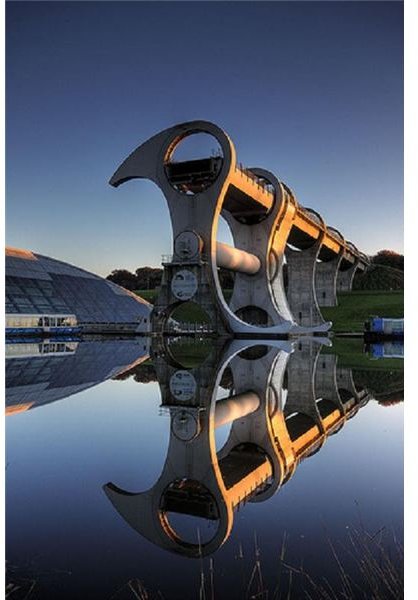The Falkirk Water Wheel in Scotland: Rotating Boat Lift
New Link for the Forth and Clyde Canal and the Union Canal
The Forth and Clyde Canal lays 35 meters below the level of the Union Canal. In the past, these two Scottish Canals were joined by the Falkirk, a flight of 11 locks that allowed boats to traverse the height across a distance of 1.5 km. Unfortunately, the Falkirk locks were dismantled in 1933. British Waterways together with Morrison-Bachy-Soletanche, Ove Arup Consultants, Butterley Engineering, and Scotland-based RMJM architects created the innovative Falkirk Wheel to connect the two canals once again.
Boat lift concepts are not new. They actually date back to 19th century Europe. However, the use of a boat lift in this particular location was not considered seriously by British Waterways until 1994. British Waterways wanted a unique structure to market the new millennium, and they definitely achieved that with the Falkirk Wheel.
The Falkirk Wheel lies at one end of a reinforced concrete aqueduct. The aqueduct connects to the Union Canal. Boats enter the Wheel’s upper gondola and are then lowered with the water that they are in to the basin below. As the upper gondola is being lowered, the lower gondola, with an equal amount of weight in it, rises up.
The opening of each arm has a single curved rail that is fixed to the inner edge. Small wheels that are fitted into this rail allow each gondola to run and ensure that the gondolas always remain horizontal. Although this feature on its own is enough to ensure the stability, a back-up system of a series of linked cogs is also present to avoid any friction or sudden movement from causing the gondola to tilt. The system of cogs ensures that the two gondolas turn at the same speed but in the opposite direction to the Wheel. Only 1.5 kW of electricity and ten hydraulic motors located within the central spine are required to turn the Wheel.
The total weight of the water and boat filled gondolas is 600 tons. As this load is rotated around the central spine of the Wheel, the stresses on the structure change significantly. Therefore, it was necessary to bolt the steel sections of the Wheel together instead of welding them. Welded joints would have been likely to fatigue under such extreme stresses. More than 15,000 hand-tightened bolts are used to connect the steel sections.
The Falkirk Wheel was constructed in sections and assembled at the Butterley Engineering’s Steelworks in Derbyshire. The wheel is constructed of 1,200 tons of steel and needed to be assembled to an accuracy of 10 mm to ensure the perfect fit and operation. Once the fit was tested at the steelworks, the Wheel was disassembled and transported by road to Falkirk. It was then bolted back together and lifted into position in five separate sections.
The Falkirk Wheel was officially opened on 24 May 2002 and is located near the Rough Castle Fort, near the village of Tamfourhill, Scotland.
About the author: Renee McClellan is a practicing mechanical engineer working within the automotive industry. She has over fifteen years of experience.
Falkirk Wheel Images

